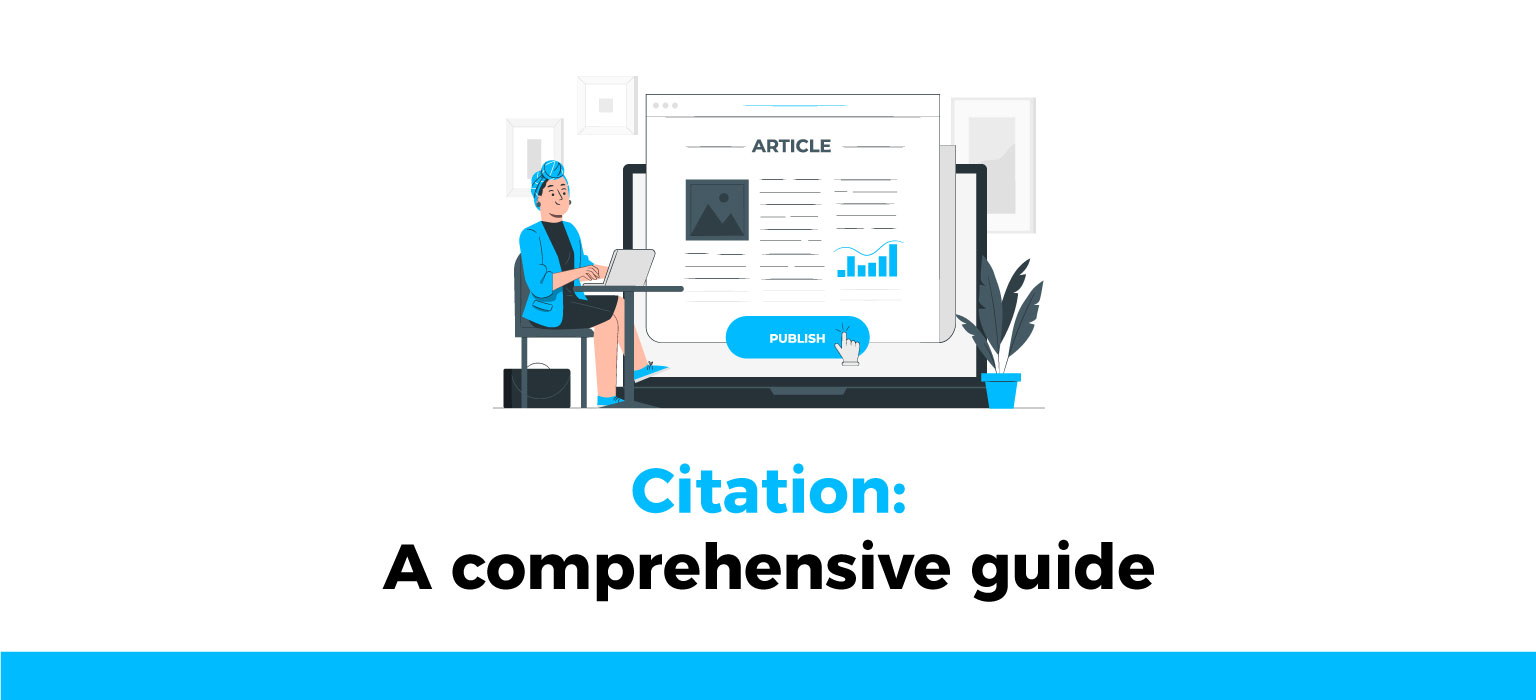Citations are a reference list to indicate that specific information used in your paper is obtained from external sources. You must cite when you receive ideas, phrases, or thoughts from others from external sources to support your work in a more tangible form. In this way, you are not violating academic integrity but gradually building it.
By citing in your paper, you are giving credit to the authors of the sources that have contributed to your writing. You are also avoiding plagiarism and creating trust and respect from others.
Citation means more than avoiding plagiarism. By using quotations, we are positioning our work in a particular field and verifying what we have already claimed.
We are also providing additional resources for our readers and giving due credit to the authors through whose materials we expand our writings.
Citation definition
Citation means giving credit to the respective author or source from which you took phrases for your material. In this way, you respect the other’s work and provide authority to your work.
Why is citation necessary?
Citations are necessary to give credit to the corresponding author and give higher authority to your work. By citing, you are accurately indicating the specific broad context of the topic.
Through quotes, you are not only helping your work to look more authentic, but you are also helping others to expand their ideas. Each reader may want a broader view of the topic you have written, perhaps even to include it in his work.
So your citations can be an additional help to your readers in their work in addition to your blog. The citations also show that you have done research during your work process, showing interest in work and respect for others.
What should they contain?
Citations are necessary when you take phrases from a book or a magazine. These are used as reference lists or bibliographies, depending on the number of sources.
Citations should appear as soon as you have summarized an idea or thought of someone else. In this form, you are also making a difference between your original ideas and ideas taken from outside.
Your professor or even your audience will have an easier time distinguishing your original work from the accepted one.
Book citations and article citations differ slightly. Let’s see what’s involved with citing books and articles.
The content of the citation for a book follows this form:
- Author’s name
- The title of the book
- Place of publication
- The publisher
- Publication date
While for an article, the citation must be in this form:
- Author’s name
- Title of the article
- The title of the magazine or website
- Volume number
- Page number (where the specific phrase is taken from)
- Publication date

Citation styles and their examples
The citation styles must always be considered when citing sources in your paper. They must be written in the format requested by the professor or in the most demanded form. Throughout the citation, you must follow the required style rules.
Commonly used citation styles are:
- APA style
- MLA style
- Chicago style
The citation content is included in these styles with some rules as follows.
APA style
APA style supports the author-date citation method. Citations should appear within the text immediately after the phrase you have taken from an external source. In the citation made for terms taken from the book, the author’s last name and the year of publication should be included, e.g. (Franck, 1966-1968).
The entire content, however, of the citation appears in the reference list at the bottom of the paper page.
While for citations, phrases taken from online websites must include: the author’s last name, initials (and year), article title, journal title, volume number, issue or part number, optional, page number, DOI, or retrieved URL.
For example (Crossplag – team, (2022), ‘How to manage time as a student?’ Crossplag.com, retrieved from http://54.93.61.191/how-to-manage-time-as-a-student/.
These are two forms of citations in APA format, one for books and the other for online websites. The most detailed part of these citations should be included at the end of the paper or in the bibliography.
MLA style
In-text citations in this format are intended to be used immediately after a direct phrase.
Therefore, even though in MLA format, it is provided that the citations be made on a particular page at the end, direct citations are still allowed.
Therefore, in-text citations for phrases taken from the book are intended to include the author’s name and page number, such as (Franck, 167).
A citation for a phrase taken directly from the article includes the author’s name, article title, copyright holder, contributors, version, numbers, location, DOI, or URL.
E.g. (Crossplag Team, ‘How to manage time as a student?’, Crossplag™, ‘http://54.93.61.191/how-to-manage-time-as-a-student/.’
In this form, phrases taken directly from books or websites are quoted. The rest of the detailed part appears in the reference list or bibliography.
Chicago Style
The Chicago format style is helpful for two types of citations: bibliographic notes and in-text.
This style is preferable for the bibliography, where the citations are placed in footnotes or endnotes and are referred to a complete list at the end of the works with detailed information for your readers.
The citation within the text is done through brackets with a symbol above the text, which is linked in the detailed list at the end of the paper.
In-text book citation includes the author’s last name, book title, and page number—Eg (Franck, Bibliographic index: a cumulative bibliography of bibliographies, 154).
Citation for the website in the text includes the author’s last name, “Title of article,” page number(s), and URL. e.g., Crossplag Team, “How to manage time as a student?”, ‘http://54.93.61.191/how-to-manage-time-as-a-student/.
Otherwise, as mentioned above, all these citations in the text must have a symbol above the citation to be linked to the list of references where there is a more in-depth citation for the entire research.
So all citation styles require the main points to be included in one sentence. So, these help you stay away from plagiarism and allow your readers to get information about it.

Why is it essential?
Citation is essential, whether in a simple essay or academic writing. You will not violate academic integrity and avoid plagiarism if you quote in your papers.
There are five fundamental reasons why citation is necessary and helps you in your paper.
1. It is essential to give credit to the respective authors to verify your work somehow.
2. Citation helps you become more proficient in your field of study.
3. Citation helps your topic to be more apparent to the readers
4. Making a simple and concise bibliography is crucial because it shows that you are doing your research correctly.
5. Citations also build credibility with your audience for you
For quoted parts, you can use plagiarism detectors, as they are used to detect plagiarism.
A plagiarism detector that looks at quoted parts is Crossplag, where even if you forgot to cite any piece, you can find out through Crossplag. Citations are also essential to give due credit to those who contributed to your paper.
In this form, you are not plagiarizing but strengthening yourself with the knowledge you get from what is written in front of you. For each phrase taken, do not leave aside the quote because it is the critical point of your work.
Conclusion
Citations are references used to show that a particular part came from an external source. Quotation marks are also used for published or unpublished works from which you have expanded your ideas.
In this form, you also give your readers access to gain more knowledge about the topic. The citation method depends on the citation style assigned by your professor.
The purpose of citations is to recognize the authors or external sources that contributed to your paper and verify your research process in some way. For each document, citations give greater authority and strength to that paper and you as its writer.
Citations are essential, as mentioned above, to avoid plagiarism, so as long as you cite, your work cannot be called plagiarism. However, it is evaluated as a work with authority and comprehensiveness.
You must know how to cite reliable sources, and always check your paper in the form to see if you need to cite any part during the process. So, a citation is the best way to do a decent job for yourself and the audience.

Agnesa is crazy about math and has won lots of prizes. Although her main gig is being a full-stack developer, she also likes to write about topics she knows really well.
But, Agnesa isn’t just about numbers and algorithms.
When she’s not crunching code or weaving words, you’ll find her conquering mountains with her trusty hiking boots!

